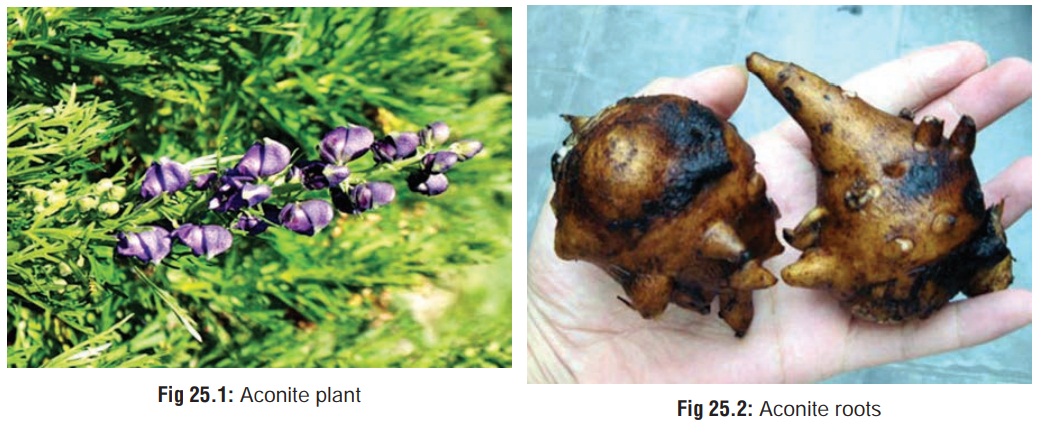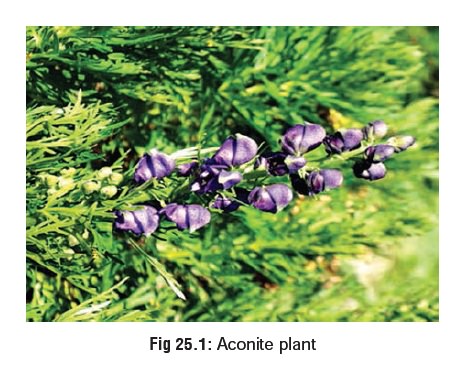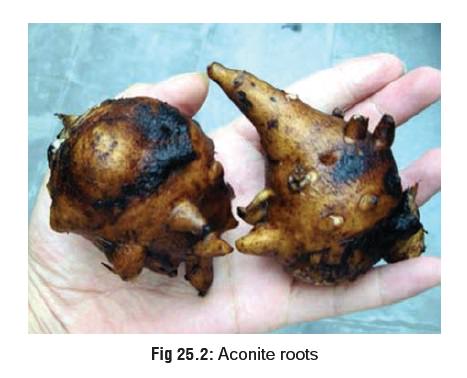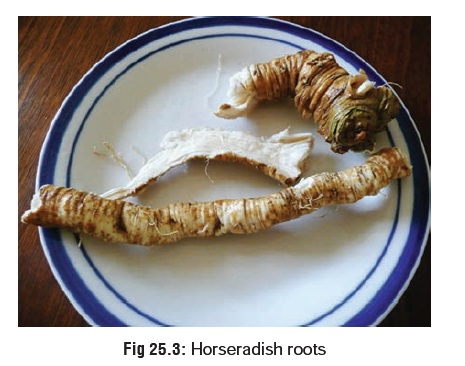Chapter: Modern Medical Toxicology: Cardiovascular Poisons: Cardiotoxic Plants
Aconite - Cardiotoxic Plant

Aconite
Other Common Names
Monkshood, Wolfsbane, Mousebane, Helmet flower, Soldier’s
cap, Old wife’s hood, Friar’s cap, Bear’s foot.
Botanical Name
Aconitum species,
of which there are 350 worldwide.
Aconitum napellus is the European variety, A. columbianum, A. reclinatum, and A. uncinatum are encountered in America, A. japonicum, and A.
carmichaelii are Oriental varieties,while Indian species include A. ferox, A. chasmanthum, A.cordatum, and A. balfouri.
Physical Appearance
This plant belongs to family Ranunculaceae and grows well in the hilly regions of Northern and Eastern parts of India, extending from Assam to Kashmir. It is a perennial herb with distinctive helmet shaped flowers, which may be blue, purple, or pinkish white in colour (Fig 25.1). The root is stout and dark (Fig 25.2), and has a superficial resemblance to horseradish (Fig 25.3).



Toxic Part
All parts, but the root is most toxic. It is said to have a
bitter-sweet taste.*
Toxic Principles
·
European and American species
contain aconitine, mesa-conitine, and jesaconitine.
·
Indian species contain hypoaconitine
and mesoaconitine which are less potent.
Aconite species contain diterpene (C20) and norditerpene
(C19) alkaloids, the nitrogen molecule of which is usually ethylated or
methylated to make them alkamines. C20 diter-penes are relatively low in
toxicity, but the esterified, nord-iterpene bases have high toxicity. If the
ester functions are hydrolysed, toxicity is reduced to that of ordinary
diterpenes.
Uses
·
The tuber is very popular in Chinese
medicine for the treat-ment of various ailments. The root is usually processed
by drying, soaking, or boiling, which significantly reduces its toxicity. Raw
aconite roots are highly toxic. Herbal decoctions of aconite are generally
prepared by soaking the roots in water or saturated lime water and then
boiling. This causes hydrolysis of aconite alkaloids to less toxic
benzylaconine and aconine derivatives.
·
Aconite is also used in Indian folk
remedies. It is also used as an antipyretic in Ayurvedic medicine, after
“detoxifica-tion”.
·
Formerly, aconite found mention in
the British Pharmacopoeia (until 1953), but today it is only used in allopathic
medicine as a proarrhythmic agent in animal studies to test the efficacy of
antiarrhythmic agents.
·
Aconite is sometimes used as an
abortifacient.
Usual Fatal Dose
· About 9 to 18 grams of root.
· About 3 to 5 mg of aconitine.
· About 10 to 15 ml of tincture.
However,
deaths have been reported with as little as 1 grams of root, 0.2 mg of
aconitine, and 5 ml of aconite tincture. It has been estimated that an adult
lethal dose is generally about 1 grams of plant part (root), 5 ml of a prepared
tincture, or 2 mg of pure aconite.
Drying
and storing these plants could result in changes in the composition and even
transformation of the alkaloidal content, thus altering toxicity of individual
exposures.
Mode of Action
Aconitine acts on nerve axons by opening sodium channels, as
well as by inhibiting complete repolarisation of the membrane of myocardial
tissue, causing repetitive firing.
Aconitine also stimulates the vagal medullary centre.
Clinical Features
Symptoms
generally begin within 10 to 20 minutes of ingestion. A tingling or burning
sensation in the fingers and toes is usually seen first, followed by sweats and
chills, a generalised paraes-thesia, dryness of mouth, and numbness. The
following are seen:
·
GIT: Nausea, hypersalivation, vomiting,
diarrhoea.Chewing on a root may cause swelling of the lips, tongue, and mouth,
making speech difficult.
·
CVS: Palpitations, hypotension,
ventricular ectopics, ar-rhythmias, AV block.
·
CNS: Tingling and numbness of mouth and
lips whichmay extend to the limbs, followed by convulsions. Initial feelings of
numbness may progress to paralysis of the skeletal muscles. Vertigo is often
present. The following have been reported: severe headache, restlessness, and
confusion. Muscular fasciculations may lead to tonic or clonic seizures. Ataxia
is often present.
·
RS: A few patients have reported
breathing difficulty afteringesting aconite-containing herbals. Pulmonary
oedema often occurs in the terminal stages.
·
Eye: Visual blurring, fluctuant pupils (hippus), mydriasis.Miosis may be seen
until the patient develops hypoxia. Xanthopsia (yellow halos around objects)
has been reported.
·
Metabolic acidosis has developed in a few patients.
·
Death usually occurs from ventricular arrhythmias or
respiratory paralysis, and this may happen in just a few minutes, or take
several days.
Treatment
·
Gastric decontamination (lavage, charcoal).
·
Perform an arterial blood gas, serum electrolytes, creatine
phosphokinase (fractionated), and an ECG.
·
Provide airway support, and establish vascular access.
·
Extensive vomiting and diarrhoea often necessitate fluid and
electrolytes to be given in substantial doses.
·
There is no specific antidote. Treatment is symptomatic and
supportive after decontamination.
·
Treat convulsions with benzodiazepines, followed by
phenytoin, if required.
·
Treat metabolic acidosis and hypokalaemia.
·
Bradyarrhythmia and hypersalivation respond to atropine.
·
Institute continuous cardiac monitoring. Arrhythmias are
unfortunately often refractory to drug management. No single antiarrhythmic
agent has been found to be uniformly effective for controlling
tachyarrhythmias. DC cardiover-sion is not effective. Calcium gluconate or
chloride may help reverse arrhythmias in some cases. They must be followed up
with magnesium sulfate.
·
In one animal study, flecainide, a sodium-channel blocker,
as well as a beta blocker, was an effective antiarrhythmic for aconite
poisoning.
·
In one patient with severe aconite-induced cardiotoxicity,
cardiopulmonary bypass and a left ventricular assist device were found to be
beneficial.
Forensic Issues
·
Poisoning with aconite has never been common. Most reported
cases are accidental in nature, resulting from thera-peutic misadventures.
Aconite is used in herbal medicines (cold preparation, antipyretic, digestive
and general tonic, etc.), or to increase the intoxicating effect of alcoholic
beverages. Fatalities have been reported with the use of tincture aconite added
to liquor.
· A few cases result from mistaken
identity with horse-radish.* Rarely, suicides and homicides have been reported.
Related Topics